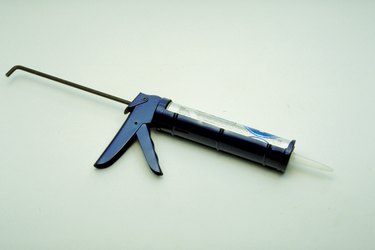Things You'll Need
Dropcloth
4 mil plastic sheeting
Stapler
Measuring tape
Jig saw
Cement board
Stud finder
Marker
1 ¼ inch hot-dipped galvanized roofing nails
2 inch wide fiberglass mesh cement board tape
Thin-set adhesive
Silicone caulk

Installing bathroom tile requires that you keep in mind the need for complete waterproofing throughout the entire installation process. Water can ruin the best tile installations, destroy bathroom walls quickly, and seep through floors to attack foundations if the waterproofing is badly done. Fortunately, waterproofing an enclosure is only a matter of proper preparation of the walls before the first tile is laid. With the installation of a waterproof membrane, followed by water resistant cement boards, your enclosure will be safely sealed, usually within the course of a single afternoon's work.
Step 1
Cover the tub with a dropcloth and tape the edges flat to the surrounding surfaces to seal the cloth in place, protecting the tub from debris.
Video of the Day
Step 2
Prepare the existing walls for the tile installation. Remove any items from your walls such as shelves trim or fixtures. If the walls are painted or wallpaper is present where tile will be placed, sand the surface of the paint to remove any finish, and strip the wallpaper away from the wall, removing any adhesive with sandpaper.
Step 3
Waterproof the walls by stapling a layer of plastic sheeting onto the wall's surface. Cover the entire surface of the wall where the tile will be placed, securing it flush against any corners to prevent tearing. The sheeting will form a water vapor barrier between the wall and the cement board.
Step 4
Measure the wall surface where the cement board will be placed to support the tiles. Cut the board to measurements using a jig saw. Allow a ¼ inch gap between the boards and the tub for movement of the tub floor or walls due to temperature changes and settlement of the house. Cut holes in the board for fixture placements.
Step 5
Locate the wall studs using a stud finder and mark the location using a piece of chalk on the ceilings and tub edge.
Step 6
Hang the cement board into place, nailing it to the wall studs with the roofing nails. Butt the edges of the cement boards as closely together as possible.
Step 7
Place fiberglass tape along all seams and corners of the cement board. Mix the thin-set mortar according to the manufacturer's instructions and then place a layer of the thin-set over the fiberglass tape to create a seal.
Step 8
Place a line of caulk along the one-quarter inch gap at the bottom of the cement board to seal the wall from water seeping through the tile covering. By closing the final gap you seal the entire surface of the cement board and complete the waterproofing process in preparation for the tile installation.
Step 9
Remove the dropcloth or leave in place for the tile installation.
Tip
If installing tiles using mastic hang the cement board with the smooth side facing the room, for mortar-based installs, face the rough side of the board towards the room.
Video of the Day